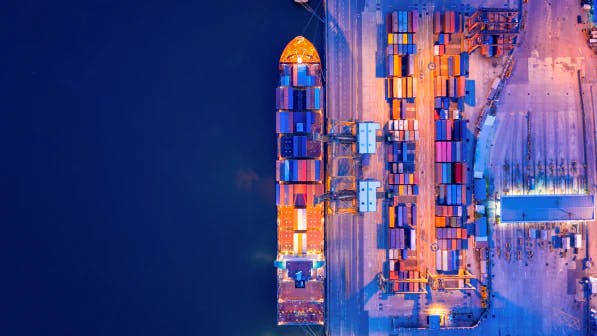Contact us
Reach out to us and a representative from one of our 26 worldwide office locations will contact you shortly.
Please login to your designated client portal:
Article - July 10, 2023

Voyage optimization has been a staple of ship routing for decades. However, in recent years, the original principles behind the services, the safety of crew, vessels, and cargo, have been complemented by an additional important priority, namely, an increasing focus on fuel efficiency and decarbonization as set out by the IMO. These principles must be in the DNA of any company purporting to provide accurate and efficient route optimization services.
The emission reduction goals are clear and require a 55% reduction in CO2 emissions by 2030. This is undoubtably an ambitious target and is certainly achievable if full use is made by the shipping industry to reduce CO2 emissions.
In this article, we will focus on how voyage optimization can greatly help owners and operators decarbonize their commercial shipping activities. The best argument for adopting a voyage optimization policy is that the decarbonization results are immediate, there is no investment needed and there are few alternatives that give such a great effect. Optimization actually starts before the vessel departs on the ballast leg of its voyage, and continues throughout the entirety of the ballast/laden passages.
During the pre-fixture stage of a voyage, the charterer/freight trader needs to make accurate calculations to establish profit and loss, the Time Charter Equivalent (TCE). These calculations should include an accurate assessment of the expected Sea Margin. It also allows for the best estimate of the expected fuel consumption and a benchmark against which results can be measured. StormGeo can provide vessel and season specific Sea Margins for all global voyages allowing for the expected effect of the weather, sea, and current conditions. We can even help to assess total CO2 emissions during the pre-fixture stage for better environmental considerations.
Once a vessel is nominated for a particular cargo a voyage preplan is prepared, indicating the various route options available, given the specifics of the vessel and either the latest forecast or expected climatological average conditions if the sailing date is outwith the forecast date range. This preplan lets the operator actively engage in the routing decision to ensure the most efficient passage.
Once the choice of optimized route is made and communicated to all relevant parties, StormGeo will continue to optimize both the vessel’s capability in the conditions encountered and the optimum track to follow to ensure that capability is best harnessed.
During the voyage, the optimum route is continuously updated according to the latest weather forecast, and any change in the recommendation is presented to the vessel. In many cases, the optimum route can be to sail a longer distance route in more favorable weather conditions, saving both fuel and time. It is always a fine balance between distance, time, and consumption, with all these criteria directly affecting the vessel/voyage efficiency.
At StormGeo, we have web-based applications that monitor vessel emissions in real-time, allowing the operator to follow the vessel’s performance based on the most up-to-date and detailed data.
With any optimization service, shipping companies must inform their service provider what their requirement is relative to the desired outcome. Are they looking for the quickest passage or minimum consumption? How much control do they have over the crew onboard with regard to speed and consumption settings/capabilities?
Traditionally, vessels aim to maintain a constant speed, even in adverse weather. This burns fuel at an exponential rate due to the vessel's need to increase power output to maintain a constant speed. Despite the vessel's efforts, speed is often lost in the process. StormGeo developed and launched Strategic Power Routing, which is designed to ensure the ship’s power is delivered at a ‘constant power setting,’ thereby keeping fuel consumption constant. We achieve this by providing the vessel with daily RPM advice needed to achieve constant power in the encountered weather and current conditions and the forecast ahead. We have a team of experts continually monitoring each vessel to ensure the crew onboard follows our advice. Part of this communication process also involves determining when and how many auxiliary power units to have operational as we often see multiple units engaged when a single unit is sufficient given the expected load. Strategic Power Routing significantly contributes to reducing fuel consumption, and our figures indicate vessels under this service can easily attain a 3-5% fuel saving.